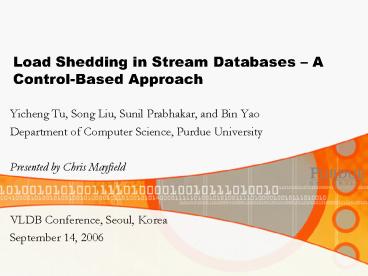Load Shedding in Stream Databases PowerPoint PPT Presentation
1 / 19
Title: Load Shedding in Stream Databases
1
Load Shedding in Stream Databases A
Control-Based Approach
- Yicheng Tu, Song Liu, Sunil Prabhakar, and Bin
Yao - Department of Computer Science, Purdue University
- Presented by Chris Mayfield
- VLDB Conference, Seoul, Korea
- September 14, 2006
2
Data stream management systems
- Applications
- Financial analysis
- Mobile services
- Sensor networks
- Network monitoring
- More
- Continuous data, discarded after being processed
- Continuous query
- Data-active query-passive model
3
DSMS architecture
- Network of query operators (O1 O3)
- Each operator has its own queue (q1 q4)
- Scheduler decides which operator to execute
- Query results (Q1, Q2) pushed to clients
- Example systems
- Aurora/Borealis
- STREAM
4
Quality in DSMS data processing
- Data processing in DSMS is quality-critical
- tuple delay
- data loss
- sampling rate, window size,
- Overloading during spikes ? degraded quality
(delay) - Solution adjust data loss (i.e., load shedding)
- On DSMS side
- Eliminating excessive load by dropping data items
- The real problem is
tuple delay is the major concern results
generated from old data are useless!
How to maintain processing delays while
minimizing data loss ?
5
Related work (load shedding)
- Accuracy of aggregate queries under load shedding
(Babcock et al., ICDE04) - Data triage (Reiss Hellerstein, ICDE05)
- Put data into an asylum upon overloading
- LoadStar (Chi et al., VLDB05)
- QoS-driven load shedding (Tatbul et al., VLDB03)
- Key questions
- - When?
- - How much?
- - Where?
- Use a load shedding roadmap (LSRM) to decide
where - Intuitive algorithm to decide when and how much
6
Example Limitations
- Highly dynamic environment is reality
- Bursty data input
- Variable unit processing cost
- Fails to capture current system status (queue
length) and output (delay) - Delay positively related to queue length
- Example 1. Unbounded increase of delay
- Example 2. Unnecessary data loss
7
Our approach
- View load shedding as a control theory problem
- Control manipulation of system behavior by
adjusting input - Cruise control of automobiles, room temperature
control, etc. - Open-loop (preset) vs. closed-loop (feedback)
control
- The feedback control loop
- Plant
- Monitor
- Controller
- Actuator
- How it works
- Error (e) desirable output (yr) - measured
output (y) - Focal point controller, which maps e to control
signal u - Disturbances
8
Challenges (theory ? practice)
- Can we model the system?
- Analytical model may not be easy to derive
- System identification experimental methods
- How to design the controller?
- Use control theoretical tools for guaranteed
performance - DSMS-specific problems
- Lack of real-time measurement of output signal (
y ) - How to set control period (T)
- Real system evaluation
- we use Borealis in our study
9
Modeling a DSMS
- Borealis data stream manager
- Round robin operator scheduler
- FIFO waiting queues
- For now, fix the per-tuple processing cost c
- Proposed model
- y qc
- where q is the number of outstanding data tuples
- Discrete form y(k) q(k-1) c
- Denote the input load as fi and system processing
power as fo
10
Controller design
- Design based on pole placement
- Locations tell how fast/well system responds
- Guaranteed performance targeting
- Convergence rate - responsiveness
- Damping - smoothness
- The controller (see appendix for details)
11
Control period
- Provides more complete answer to the question
when to shed load? - Empirically set in previous studies
- Case-by-case decision with some systematic rules
- In our problem, a tradeoff between
- Sampling theory (Nyquist-Shannon Theorem) in
order to capture the moving trends of the
disturbances, higher (shorter) sampling frequency
(period) is preferred - Stochastic feature of output ( y ) and parameter
( c ) - more samples are needed ? longer period is
preferred - The first factor should be given more weight
12
Input for experiments
- Controller and load shedder implemented in
Borealis - Synthetic (Pareto) and real (Web) data
streams - Small query network with variable average
processing cost
13
Experimental results
- Experiments for comparison
- Aurora open loop solution
- Baseline a simple feedback method
- Target delay 2 sec
- Control period 1 sec
- Total time 400 sec
- For both input types, data loss are almost the
same for all three load shedding strategies
14
Future work
- Time-varying DSMS model
- For example, time-varying cost c
- Possible solution adaptive control
- Adaptation other than load shedding
- New disturbances?
- Model changes? (i.e. at runtime)
- Other database problems
15
Summary
- Load shedding is an effective quality adaptation
method - Ad hoc solutions do not work well under dynamic
load and system features - We propose an approach to guide load shedding in
a highly dynamic environment based on feedback
control theory - Initial experimental results performed in a
real-world DSMS show promising potential of our
approach
16
Backup - 1
17
Backup - 2
- Lack of robustness of open-loop solution
- More optimistic policy adapted in Aurora
- Unstable performance
- Our solution is robust
- Under input streams with different burstiness
18
Backup - 3
19
Backup - 4 (Model verification)
- Feed Borealis with synthetic streams
- Input rate step or sinusoidal function of time
- Average processing cost is fixed

